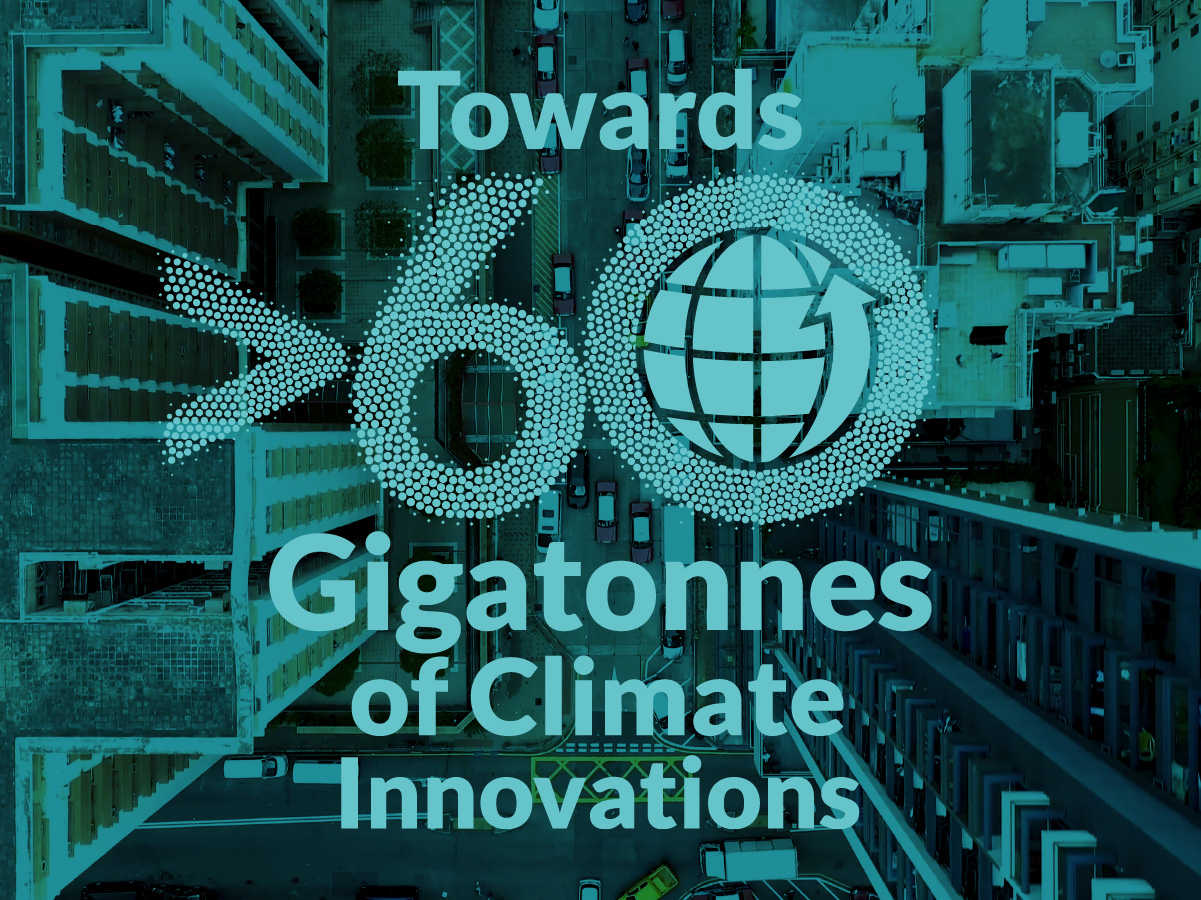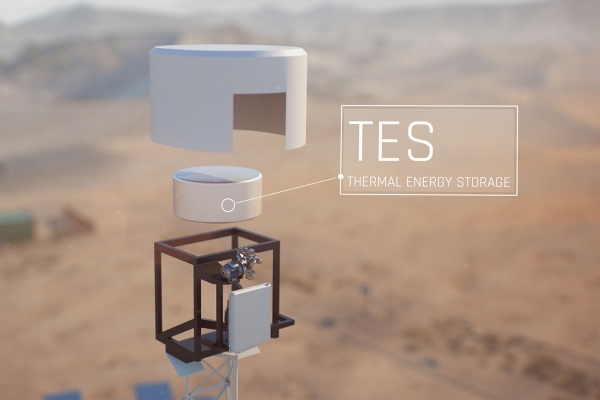Nominated innovations
1000 innovative clean energy solutions and > 150 framework enablers with the potential to deliver more than twelve gigatonnes of avoided emissions by 2030
These assessments are based on a basic avoided emission assessment. The overall concept of avoided emissions is that a solution (product or service) enables the same function to be performed with significantly less GHG emissions. The method of measuring avoided emissions, is to compare a baseline scenario without the enabling solution, with a scenario using the enabling solution; whereby the baseline represents the ‘business as usual’ (BAU) scenario.
These assessments are based on the framework document: The Avoided Emissions Framework (AEF) from September 2020

Active acoustic spectroscopy
The Active Acoustic Spectroscopy is a device that can measure different parameters, such as e.g. density and viscosity, in different flowing matters in pipes. This is done by analysing how the acoustics in a pipe is affected by the flowing matters. With the help of this, data analysis can be done to optimise production processes within industries. Analysis optimisations may increase e.g. material yield or energy output. The Active Acoustic Spectroscopy can be used in different industries, but the focus market is pulp and paper industries to begin with.
Sweden
≈10

Acosense AB
Active acoustic spectroscopy
The Active Acoustic Spectroscopy is a device that can measure different parameters, such as e.g. density and viscosity, in different flowing matters in pipes. This is done by analysing how the acoustics in a pipe is affected by the flowing matters. With the help of this, data analysis can be done to optimise production processes within industries. Analysis optimisations may increase e.g. material yield or energy output. The Active Acoustic Spectroscopy can be used in different industries, but the focus market is pulp and paper industries to begin with.
≈10Mt CO2e/year

Sensor technology for increased battery efficiency
The innovation is focused on upgraded batteries and their use for energy storage devices and in vehicles. The batteries are built with a sensor that helps monitor and control the batteries, achieve an increased energy availability, power density, charge rate etc. When installed in t comes to vehicles, the batteries are measured to get more effect out of each battery and can be beneficial for both price, weight, and volume. The same battery is also expected to give more mileage and faster charge rate. When it comes to battery storage, the batteries are expected to even out energy supply over time since the batteries are suitable for energy storage.
Sweden

Insplorion AB
Sensor technology for increased battery efficiency
The innovation is focused on upgraded batteries and their use for energy storage devices and in vehicles. The batteries are built with a sensor that helps monitor and control the batteries, achieve an increased energy availability, power density, charge rate etc. When installed in t comes to vehicles, the batteries are measured to get more effect out of each battery and can be beneficial for both price, weight, and volume. The same battery is also expected to give more mileage and faster charge rate. When it comes to battery storage, the batteries are expected to even out energy supply over time since the batteries are suitable for energy storage.
Currently unavailable

Thin CIGS solar cells
Midsummer’s innovation Midsummer Slim, which is a solar panel composed of thin film CIGS (copper indium gallium selenide) solar cells. The solar panel is ultra-thin with a thickness of 2 mm and an average weight of 3 kg/m2. The panel can be integrated into roofing materials such as folded sheet roofs and roof tiles, and it can also be mounted externally on existing roofs. It has a nominal effect of 144 Wp and a production capacity of 100 Wp/m2. The manufacturer information states that the panel has a maximum efficiency of 16 % at a cellular level.
Sweden

Midsummer AB
Thin CIGS solar cells
Midsummer’s innovation Midsummer Slim, which is a solar panel composed of thin film CIGS (copper indium gallium selenide) solar cells. The solar panel is ultra-thin with a thickness of 2 mm and an average weight of 3 kg/m2. The panel can be integrated into roofing materials such as folded sheet roofs and roof tiles, and it can also be mounted externally on existing roofs. It has a nominal effect of 144 Wp and a production capacity of 100 Wp/m2. The manufacturer information states that the panel has a maximum efficiency of 16 % at a cellular level.
Currently unavailable

A dispatchable solar power system
The innovation is a temporary energy storage solution for thermal energy. This is done using a phase-change material based on aluminum, which is liquefied by the heat produced. When electricity is required, the heat in the material is transferred from the phase-change material via a heat transfer fluid to a Stirling engine, where the energy is converted to electricity. The thermal energy input can be excess electricity from e.g. solar panels or wind turbines, or heat from concentrated solar energy. This solution allows for storage and releasing of energy on demand based on the needs of the electricity grid.
Sweden
≈1

Azelio AB
A dispatchable solar power system
The innovation is a temporary energy storage solution for thermal energy. This is done using a phase-change material based on aluminum, which is liquefied by the heat produced. When electricity is required, the heat in the material is transferred from the phase-change material via a heat transfer fluid to a Stirling engine, where the energy is converted to electricity. The thermal energy input can be excess electricity from e.g. solar panels or wind turbines, or heat from concentrated solar energy. This solution allows for storage and releasing of energy on demand based on the needs of the electricity grid.
≈1Mt CO2e/year

Surface water cleaning using separation
Surfcleaner removes oil and other waste products such as plastic and debris from water surfaces. This is done using automatic separator that automatically drags in everything (including water) into it. The water is then removed using separation and returned to the water mass while the rest of the materials is transported to a secondary storage unit that can be emptied at will. The device itself is cheap and requires minimal service while also having a long lifetime. The solution can be applied to specific situations such as oil spills or wastewater treatment, but also for general for areas such as plastic collection.
Sweden
≈1

Surfcleaner AB
Surface water cleaning using separation
Surfcleaner removes oil and other waste products such as plastic and debris from water surfaces. This is done using automatic separator that automatically drags in everything (including water) into it. The water is then removed using separation and returned to the water mass while the rest of the materials is transported to a secondary storage unit that can be emptied at will. The device itself is cheap and requires minimal service while also having a long lifetime. The solution can be applied to specific situations such as oil spills or wastewater treatment, but also for general for areas such as plastic collection.
≈1Mt CO2e/year

Saving water and filtering out microplastics in washers
Mimbly has developed a retrofitted device, the Mimbox, that is connected to one or several washers. The water used during washing is circulated through the Mimbox, where the water quality is analyzed. If the quality is at the required standards, the water is then reused. According to Mimbly's website, this can save up to 90% of water and requires less energy that traditional use of washers. In addition, the solution also includes a filter that removes microplastics and other fibers from the water.
Sweden

Mimbly AB
Saving water and filtering out microplastics in washers
Mimbly has developed a retrofitted device, the Mimbox, that is connected to one or several washers. The water used during washing is circulated through the Mimbox, where the water quality is analyzed. If the quality is at the required standards, the water is then reused. According to Mimbly's website, this can save up to 90% of water and requires less energy that traditional use of washers. In addition, the solution also includes a filter that removes microplastics and other fibers from the water.
Currently unavailable

Autonomous and electric transport vehicles
Einride provides a sustainable transportation service, where they offer customers an electric transportation options for a wide range of goods. This is done using the Einride Pods, which are compact, truck-like vehicles that are either autonomously driven or remotely controlled by a driver. Furthermore, the solution includes a digital using an intelligent shipping platform in which users can monitor everything from booking to delivery of goods. The innovation can help users to reduce both the cost and climate impact of their activities.
Sweden

Einride AB
Autonomous and electric transport vehicles
Einride provides a sustainable transportation service, where they offer customers an electric transportation options for a wide range of goods. This is done using the Einride Pods, which are compact, truck-like vehicles that are either autonomously driven or remotely controlled by a driver. Furthermore, the solution includes a digital using an intelligent shipping platform in which users can monitor everything from booking to delivery of goods. The innovation can help users to reduce both the cost and climate impact of their activities.
Currently unavailable

Scaling sustainable transportation
Freelway has a service that optimizes transportation made by individuals and companies through visualization and coordination all transports within a system. Using algorithms to match transport requests with available resources, the solution offers one app-based service which provides economic and environmental benefits for all actors. The service also allows for the integration of a post delivery system for transporting last mile deliveries. The market group is currently rural and urban users.
Sweden

Freelway AB
Scaling sustainable transportation
Freelway has a service that optimizes transportation made by individuals and companies through visualization and coordination all transports within a system. Using algorithms to match transport requests with available resources, the solution offers one app-based service which provides economic and environmental benefits for all actors. The service also allows for the integration of a post delivery system for transporting last mile deliveries. The market group is currently rural and urban users.
Currently unavailable

Smart energy platform
Bright Energy offers electricity suppliers a tool to help their customers optimize their energy usage by showcasing all their services in one platform. This is done by, for example, visualizing total consumption for individual customers and providing real-time information for when it is not optimal to consume electricity, based on the status of the grid. Improved energy logistics can enable the introduction of more renewable energy generation, especially if more demand comes from customers. Energy savings can also be seen if consumer behavior changes.
Sweden

Bright Energy AB
Smart energy platform
Bright Energy offers electricity suppliers a tool to help their customers optimize their energy usage by showcasing all their services in one platform. This is done by, for example, visualizing total consumption for individual customers and providing real-time information for when it is not optimal to consume electricity, based on the status of the grid. Improved energy logistics can enable the introduction of more renewable energy generation, especially if more demand comes from customers. Energy savings can also be seen if consumer behavior changes.
Currently unavailable

Chemical recycling of cellulosic textile waste
Re:newcell has developed a solution to enable recycling of cotton and viscose fibers used in apparel. The solution works by collection of used garments, which is transformed to a biodegradable pulp to be used as feedstock for production of clothes. Utilizing usable material that would otherwise end up on landfills allows the apparel industry to save several thousand liters of water per kilo apparel and prevents chemicals and dyes from entering local biological systems, all while reducing the carbon footprint of the industry.
Sweden
≈100

Re:newcell AB
Chemical recycling of cellulosic textile waste
Re:newcell has developed a solution to enable recycling of cotton and viscose fibers used in apparel. The solution works by collection of used garments, which is transformed to a biodegradable pulp to be used as feedstock for production of clothes. Utilizing usable material that would otherwise end up on landfills allows the apparel industry to save several thousand liters of water per kilo apparel and prevents chemicals and dyes from entering local biological systems, all while reducing the carbon footprint of the industry.
≈100Mt CO2e/year